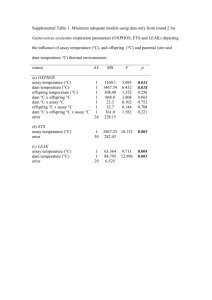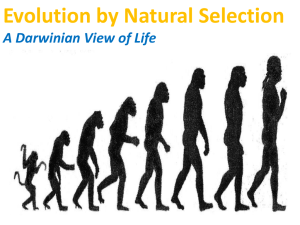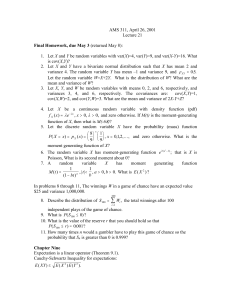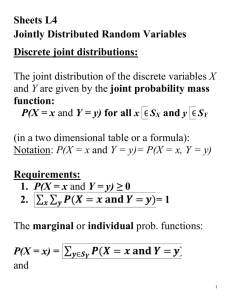Basic quantitative genetics, the “breeders equation
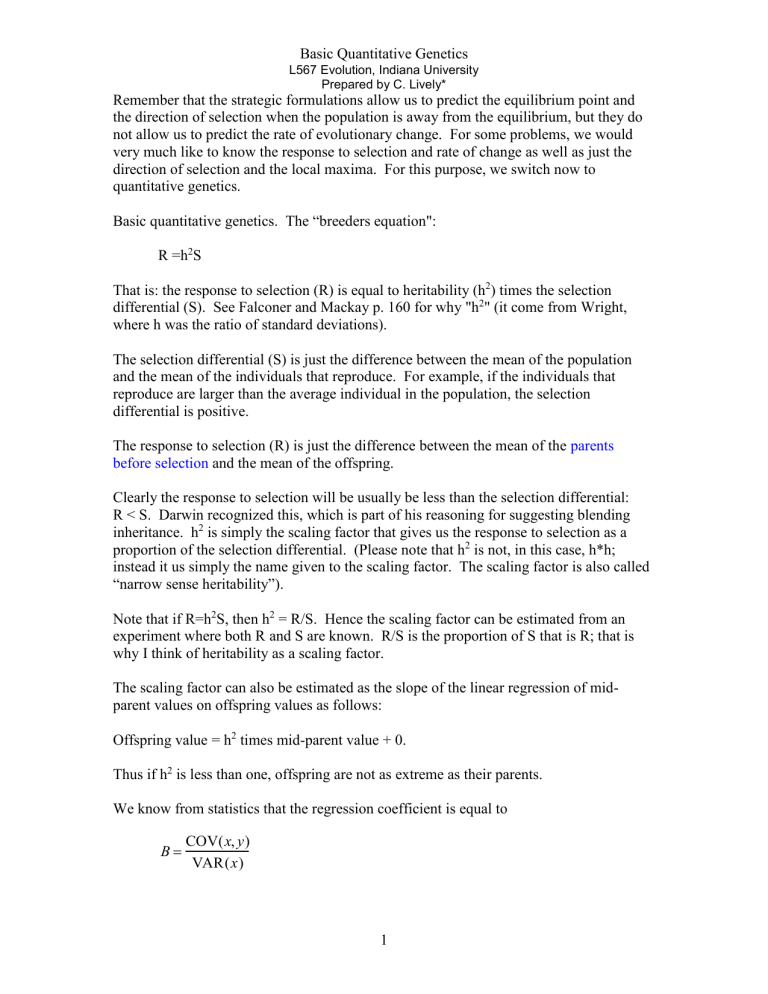
Basic Quantitative Genetics
L567 Evolution, Indiana University
Prepared by C. Lively*
Remember that the strategic formulations allow us to predict the equilibrium point and the direction of selection when the population is away from the equilibrium, but they do not allow us to predict the rate of evolutionary change. For some problems, we would very much like to know the response to selection and rate of change as well as just the direction of selection and the local maxima. For this purpose, we switch now to quantitative genetics.
Basic quantitative genetics. The “breeders equation":
R =h 2 S
That is: the response to selection (R) is equal to heritability (h 2 differential (S). See Falconer and Mackay p. 160 for why "h 2
) times the selection
" (it come from Wright, where h was the ratio of standard deviations).
The selection differential (S) is just the difference between the mean of the population and the mean of the individuals that reproduce. For example, if the individuals that reproduce are larger than the average individual in the population, the selection differential is positive.
The response to selection (R) is just the difference between the mean of the parents before selection and the mean of the offspring.
Clearly the response to selection will be usually be less than the selection differential:
R < S. Darwin recognized this, which is part of his reasoning for suggesting blending inheritance. h 2 is simply the scaling factor that gives us the response to selection as a proportion of the selection differential. (Please note that h 2 is not, in this case, h*h; instead it us simply the name given to the scaling factor. The scaling factor is also called
“narrow sense heritability”).
Note that if R=h 2 S, then h 2 = R/S. Hence the scaling factor can be estimated from an experiment where both R and S are known. R/S is the proportion of S that is R; that is why I think of heritability as a scaling factor.
The scaling factor can also be estimated as the slope of the linear regression of midparent values on offspring values as follows:
Offspring value = h
Thus if h 2
2 times mid-parent value + 0.
is less than one, offspring are not as extreme as their parents.
We know from statistics that the regression coefficient is equal to
B
COV( x , y )
VAR( x )
1
Basic Quantitative Genetics
L567 Evolution, Indiana University
Prepared by C. Lively*
For our purposes then: h
2
COV(p , o)
VAR(p )
, which in words simply means the covariation between mid-parent values and offspring values, divided by the total variation in the mid-parent values.
Covariation between parents and offspring,
COV(p ,o)
, measures the extent to which deviations from the mean in the parents are reflected in deviations in their mean in the offspring. If COV(p ,o) is positive, the deviations are correlated and in the same direction. In other words, estimation of covariance answers this question: do parents that are larger than the mean for their generation produce offspring that are larger than the mean in their generation? And, similarly, do parents that are smaller than the mean for their generation produce offspring that are smaller than the mean in their generation?
Now, and this is key: the
COV(p ,o)
is also an estimate of half the "additive genetic variation": or
COV(p ,o) =
1
V
A
.
2
And VAR( p ) is equal to one half V
P
, the total variance among parents (or the total phenotypic variance):
VAR( p ) =
1
2
V p
.
Hence: h
2
COV(p , o)
VAR(p )
0.5V
A
0.5V
p
V
A
V p
So heritability can also be expressed as h
2
V
A , the ratio of additive genetic variation to
V
P total phenotypic variation. So the scaling factor is determined by the amount of additive genetic variation relative to the total amount of phenotypic variation.
Question: when would evolution by natural selection stop happening in a QG model?
Finally, the selection differential, S, can also be estimated as
S= COV(phenotype, relative fitness)=cov( z , w ), where w is the relative fitness =
W / W
, and z is the trait value (See Lynch and Walsh, page 46).
Alternatively, S S
cov( W i
, z i
W fitness) (see Rice, page 193).
)
, where W i
is the number of offspring produced (absolute
*Mostly taken from Lynch and Walsh, pages 45-50, and Falconer and MacKay 125-127.
2


